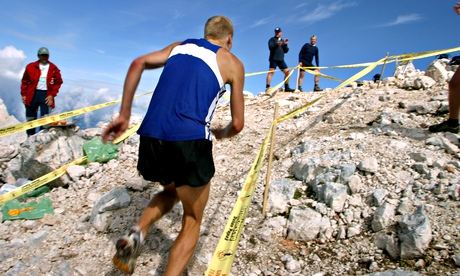
I sat at the top of the mountain for more than three hours before flying down; I've got the sunburn and the haphazard video of the flight to prove it. Fortunately no broken bones, just a descent that scared me too much to attempt.
The starting pistol had gone earlier that morning in the Swiss village of Lodrino, about half an hour north of Lugano. There was a motley crew of tough, weatherbeaten runners standing around, T-shirts broadcasting the previous races that they'd completed. Feeling rather out of my depth, I did my usual warm-up. As a regular 10km runner, I felt confident with my speed – but knew that the first five kilometres climbed no less than 1,500m.
I was greeted by the ascent almost immediately; my breathing became quickly laboured. Undeterred, I kept going. It wasn't really running. I flailed my arms around as the running poles of the other competitors swung this way and that. The steep, uneven steps had us in single file and we were leaning forward, hands on thighs. I copied the position of the other runners and tried to match them step for step. Pouring water over my head, I took a biscuit at the first refreshment stop. We were just 4km into the race now. Knowing that another 7.5km lay ahead, I worried that I had started too quickly.
It took an average of three hours for the 300 competitors to reach the summit. At 2,190m above sea level, you're greeted with unbridled enthusiasm, buckets of isotonic drinks and plates of biscuits. This particular Swiss skyrace gives you the choice of the 21km up and down race (2,100m height gain/1,800m height descent), or to finish after 11.5km at the summit of Forcarella, before hiking down unhurried to the idyllic Lavertezzo. Given my inability to descend without hysterics, it was not a decision I struggled with.
With more than half of the canton of Ticino's 2812.46 sq km covered in forests and mountains, skyrunning (running, as opposed to hiking, up and down mountains) is second nature to Swiss natives. For most of the day's competitors, scaling peaks and bounding down mountainsides was something they'd done since childhood – and it showed. They did it with the ease of mountain goats. For Brits, on the other hand, it takes a little more precaution and a lot more nerve.
Now labelled as its own discipline within the running community, skyrunning is becoming the next mass-participation event. But there's a downside: most races have extortionate entry fees, and transport to the far-flung mountains of the world isn't cheap. There is a solution – albeit a rather extreme, costly one. My boyfriend and I moved to Switzerland, placing us at the centre of the action, with a skyrace every weekend.
Today's action was centred on a rocky precipice above southern Switzerland's purportedly most picturesque valley, Valle Verzasca (you might know it from James Bond's dam bungee jump in the opening frames of GoldenEye); this marked the halfway checkpoint – or the welcome sight of the finishing mat if you were only doing the uphill race, as I was.
H
ardy hikers had ventured up the mountain earlier that morning to lend support to the competitors. As one shouted to me that I was the first woman and nearing the finish, my spirits lifted momentarily – that is, until I looked up and saw the final kilometre literally rise up. I'd seen the course's altitude profile – I'd spent the car journey analysing it, in fact – but nothing could have prepared me for a kilometre at a gradient of 50%. This wasn't running; this was scrambling, climbing and heaving my weary body up and over rocks. When had I signed up for this? I wanted to impress at the finish – after all, this was a race – but I could barely bring myself to lift my feet as I crossed the finish line. With a skyrace, the climbs are never easy, and having grown up as a runner, I find being reduced to a walk humiliating and frustrating. But with an average gradient of 15% over the whole 11.5km and a maximum gradient of 50%, this isn't a regular uphill. Given the combination of the heat, the technical nature of the trail and my own competitive nature, my weak finish was probably to be expected.
"I think you've made the right choice!" said a runner as they continued over the summit, chucking water over their head. Perplexed and exhausted, I didn't immediately realise what they meant – that is, until I peered over the other side. The descent began with a near vertical snowy ravine. "Oh, God!" I said. Seeing my discomfort, the race organisers, recognising that I was not your regular Swiss mountain runner, allowed me the luxury of returning to the valley in a helicopter. Had it been a less glamorous way of leaving the mountaintop, I may have been a little embarrassed, but we're talking about a helicopter here. What could be a more exciting way to end the day?
For many, tackling a mountain race lies in knowing, or rather not knowing, what will greet you at the top. With our calendar now full of skyraces, it's time for me to face my fears and follow this advice: "Train your weaknesses, not your strengths."

